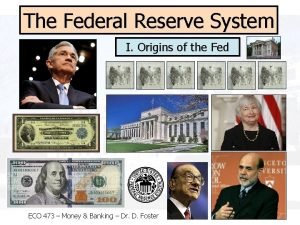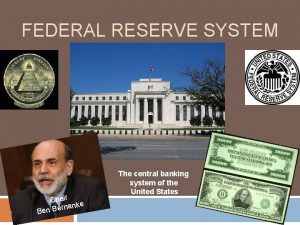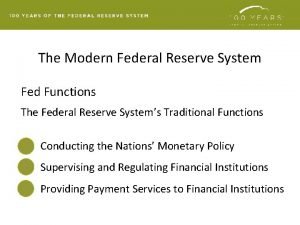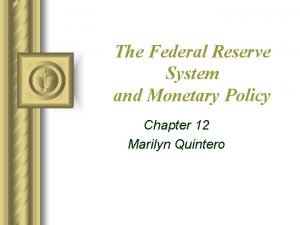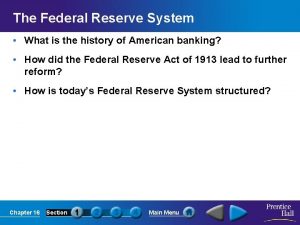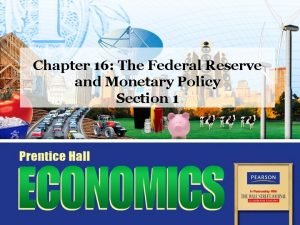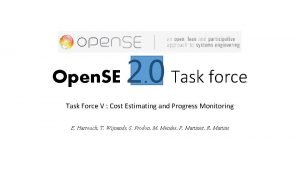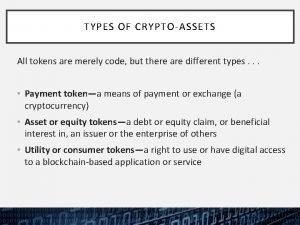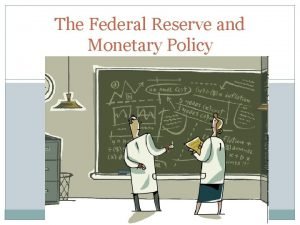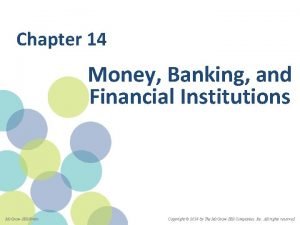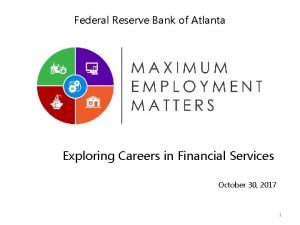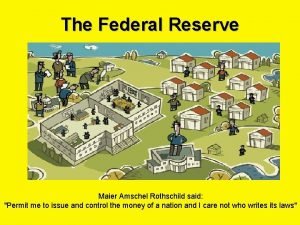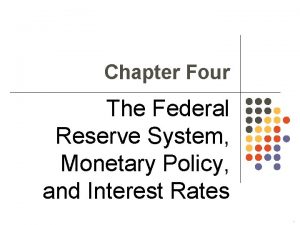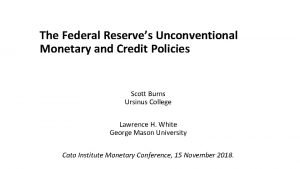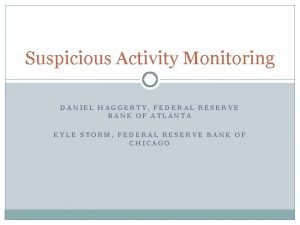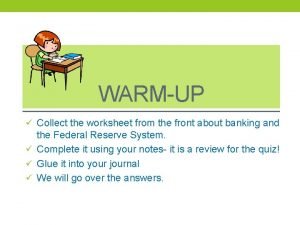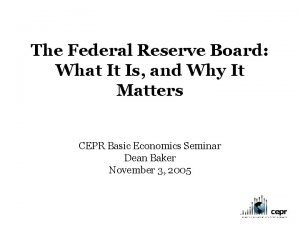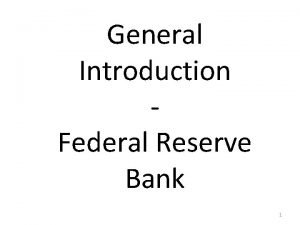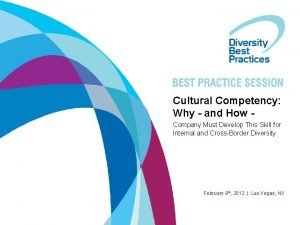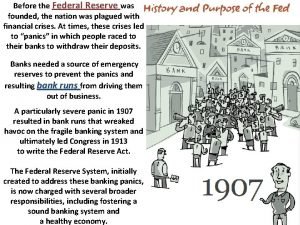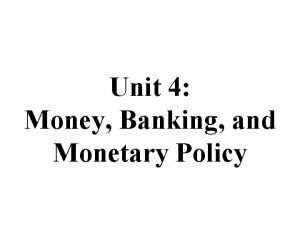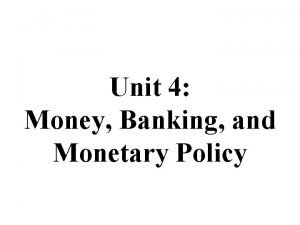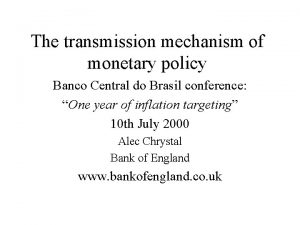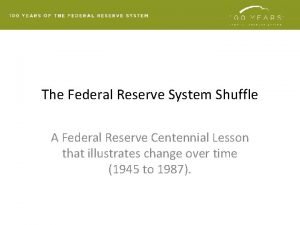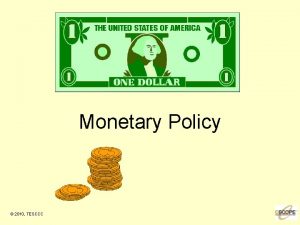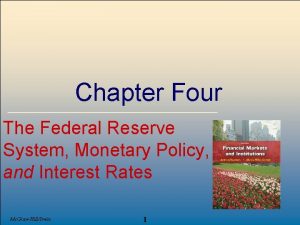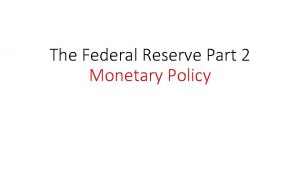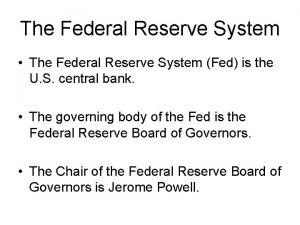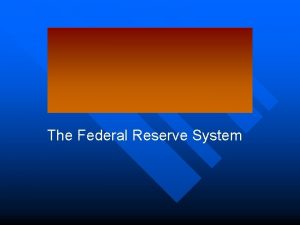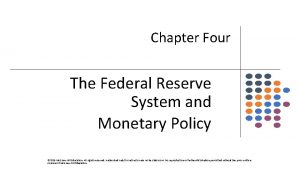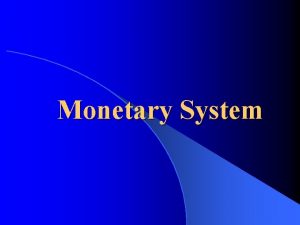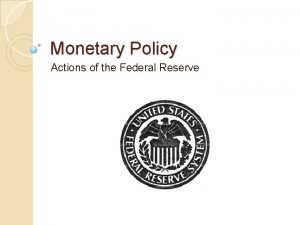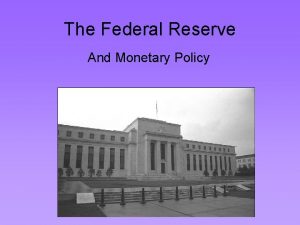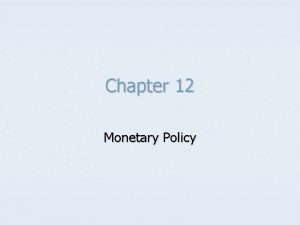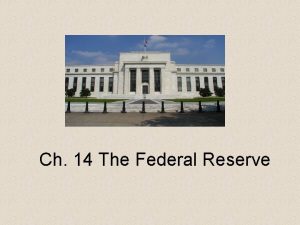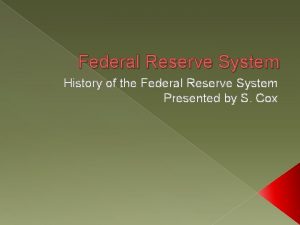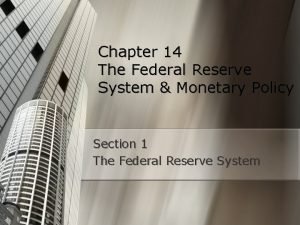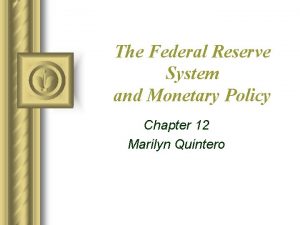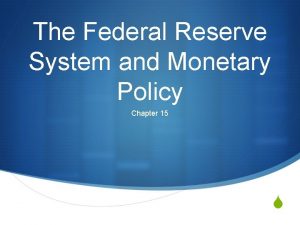Chapter Four The Federal Reserve System Monetary Policy

































- Slides: 33

Chapter Four The Federal Reserve System, Monetary Policy, and Interest Rates.

The Federal Reserve l l l Founded by Congress under the Federal Reserve Act in 1913 Subject to oversight by Congress under its authority to create money An independent central bank–its decisions do not have to be ratified by the President or Congress l Congressional oversight © 2019 Mc. Graw-Hill Education. All rights reserved. Authorized only for instructor use in the classroom. No reproduction or further distribution permitted without the prior written consent of Mc. Graw-Hill Education.

Functions of the Federal Reserve l Conduct monetary policy l Supervise and regulate depository institutions l Provide payment and other financial services to the U. S. government, the public, FIs, and foreign official institutions © 2019 Mc. Graw-Hill Education. All rights reserved. Authorized only for instructor use in the classroom. No reproduction or further distribution permitted without the prior written consent of Mc. Graw-Hill Education.

Functions of the Federal Reserve Continued l Maintain financial system stability l l The Wall Street Reform and Consumer Protection Act of July 2010 requires the Fed to supervise complex financial institutions that could generate systemic risk to the economy The Fed (and others) has now been given broader powers to seize or break up institutions whose actions could harm the economy © 2019 Mc. Graw-Hill Education. All rights reserved. Authorized only for instructor use in the classroom. No reproduction or further distribution permitted without the prior written consent of Mc. Graw-Hill Education.

Functions of the Federal Reserve Concluded l Maintain financial system stability l l Implementing federal laws designed to protect consumers in credit and other financial transactions Implementing regulations to ensure compliance, investigating complaints, and ensuring availability of services to low and moderate income groups and certain geographic regions © 2019 Mc. Graw-Hill Education. All rights reserved. Authorized only for instructor use in the classroom. No reproduction or further distribution permitted without the prior written consent of Mc. Graw-Hill Education.

Structure of the Federal Reserve l l Divided into 12 Federal Reserve districts, each with a main Federal Reserve Banks operate under the general supervision of the Board of Governors of the Federal Reserve The Office of the Comptroller of the Currency (OCC) charters national banks, which are members of the Federal Reserve System (FRS) FRS member banks “own” the 12 Federal Reserve Banks © 2019 Mc. Graw-Hill Education. All rights reserved. Authorized only for instructor use in the classroom. No reproduction or further distribution permitted without the prior written consent of Mc. Graw-Hill Education.

Board of Governors of the FRS l l Seven member board headquartered in Washington, DC President appoints and Senate confirms members to nonrenewable 14 -year terms President appoints and Senate confirms Chairman and vice-chairman to renewable 4 year terms Formulates and conducts monetary policy and supervises and regulates banks © 2019 Mc. Graw-Hill Education. All rights reserved. Authorized only for instructor use in the classroom. No reproduction or further distribution permitted without the prior written consent of Mc. Graw-Hill Education.

Federal Open Market Committee (FOMC) l FOMC consists of 12 members l l seven members of the Board of Governors the president of the Federal Reserve Bank of NY the presidents of four other Federal Reserve Banks (on a rotating basis) The major monetary policy-making body of the FRS © 2019 Mc. Graw-Hill Education. All rights reserved. Authorized only for instructor use in the classroom. No reproduction or further distribution permitted without the prior written consent of Mc. Graw-Hill Education.

Federal Open Market Committee (FOMC) Continued l Policies seek to promote full employment, economic growth, price stability, and a sustainable pattern of international trade l Are there tradeoffs between these goals? l Why is international monetary cooperation necessary? © 2019 Mc. Graw-Hill Education. All rights reserved. Authorized only for instructor use in the classroom. No reproduction or further distribution permitted without the prior written consent of Mc. Graw-Hill Education.

Federal Open Market Committee (FOMC) Concluded l l The FOMC sets ranges for growth of monetary aggregates and the fed funds rate, and also directs operations in FX markets Open market operations are the main policy tool used to achieve monetary targets: l l involve the purchase and sale of U. S. government and federal agency securities are implemented by the Federal Reserve Board Trading Desk of the New York Federal Reserve Bank © 2019 Mc. Graw-Hill Education. All rights reserved. Authorized only for instructor use in the classroom. No reproduction or further distribution permitted without the prior written consent of Mc. Graw-Hill Education.

The Fed and the Crisis l l 2007 l Term Auction Facility (TAF) created 2008 l March: Fed facilitates J. P. Morgan Chase purchase of Bear. Stearns l Term Securities Lending Facility (TSLF) created l Primary Dealer Credit Facility (PDCF): Expands discount window borrowing to investment banks l September: Lehman Brothers collapses, Goldman-Sachs and Morgan Stanley become commercial banks, Merrill-Lynch is bought by Bank of America © 2019 Mc. Graw-Hill Education. All rights reserved. Authorized only for instructor use in the classroom. No reproduction or further distribution permitted without the prior written consent of Mc. Graw-Hill Education.

The Fed and the Crisis Continued l 2008 (continued) l Asset-Backed Commercial Paper Money Market Mutual Fund Liquidity Facility, the Commercial Paper Funding Facility, the Money Market Investor Funding Facility and the Term Asset. Backed Securities Loan Facility (TALF) are created l Average weekly lending from the Fed grew from about $59 million in 2006 to almost $850 billion per week in late 2008 © 2019 Mc. Graw-Hill Education. All rights reserved. Authorized only for instructor use in the classroom. No reproduction or further distribution permitted without the prior written consent of Mc. Graw-Hill Education.

The Fed and the Crisis Concluded l l l August 2006 fed funds rate = 5. 25% April 2008 fed funds rate = 2. 00% By year end 2008 target fed funds rate between 0 and 0. 25% and the discount rate was lowered to 0. 5% November 2008 -- The Fed announces it would engage in purchasing up to $600 billion in Treasuries and mortgage-backed securities (quantitative easing) l This amount was increased to $1. 7 trillion in March 2009. November 2010 the Fed announced a new series of bond buying of up to $600 billion in what has been termed QE 2 September 2012 began QE 3, monthly purchases of Treasuries and mortgage backed securities, tapering began in 2013 © 2019 Mc. Graw-Hill Education. All rights reserved. Authorized only for instructor use in the classroom. No reproduction or further distribution permitted without the prior written consent of Mc. Graw-Hill Education.

Federal Reserve Banks l Assist in the conduct of monetary policy l l l Supervise and regulate FRS member banks l l Set and change the discount rate (must be approved by the Board of Governors) Make discount window loans to depository institutions Conduct examinations and inspections of member banks Issue warnings when banking activity is unsafe or unsound Approve bank mergers and acquisitions Provide government services l Act as the commercial banks of the U. S. Treasury © 2019 Mc. Graw-Hill Education. All rights reserved. Authorized only for instructor use in the classroom. No reproduction or further distribution permitted without the prior written consent of Mc. Graw-Hill Education.

Federal Reserve Banks l Issue new currency l l Clear checks l l Act as a central clearing system for U. S. banks Provide wire transfer services l l l Collect and replace currency in circulation as necessary Fedwire Automated Clearinghouse (ACH) Perform banking sector and economic research l Used in the formulation of monetary policy © 2019 Mc. Graw-Hill Education. All rights reserved. Authorized only for instructor use in the classroom. No reproduction or further distribution permitted without the prior written consent of Mc. Graw-Hill Education.

Discussion of the Federal Reserve l What are the implications of the bailouts of the financial crisis? Is the system safer now or can we expect another crisis in the future? l What does it mean to be too big to fail or systemically risky? Does designating an institution as systemically risky make the system safer? l What are the pros and cons of deposit insurance? Should the U. S. employ unlimited deposit insurance as some other countries do? © 2019 Mc. Graw-Hill Education. All rights reserved. Authorized only for instructor use in the classroom. No reproduction or further distribution permitted without the prior written consent of Mc. Graw-Hill Education.

Figure 4 -5: The Process of Monetary Policy Implementation

Balance Sheet of the Federal Reserve l Major liabilities l l Reserve deposits Currency in circulation l l Note that currency in circulation + reserves = monetary base Major assets l l Treasury securities U. S. government agency securities

Monetary Policy Tools l Monetary policy affects the macroeconomy by influencing the supply and demand for excess bank reserves l l Influences the money supply and the level of short-term and long-term interest rates Affects foreign exchange rates, the amount of money and credit in the economy, and the levels of employment, output, and prices © 2019 Mc. Graw-Hill Education. All rights reserved. Authorized only for instructor use in the classroom. No reproduction or further distribution permitted without the prior written consent of Mc. Graw-Hill Education.

Monetary Policy Tools Continued l Financial Services Regulatory Relief Act of 2006 l l Authorized Federal Reserve to pay interest on reserve balances held by depository institutions Federal Reserve can take one of two basic approaches to affect the market for banks’ excess reserves l l Target quantity of reserves Target interest rate on those reserves © 2019 Mc. Graw-Hill Education. All rights reserved. Authorized only for instructor use in the classroom. No reproduction or further distribution permitted without the prior written consent of Mc. Graw-Hill Education.

Open Market Operations l Open market operations l l Policy directive of the FOMC is forwarded to the Federal Reserve Board Trading Desk at the Federal Reserve Bank of New York Trading Desk manager buys or sells U. S. Treasury securities in the over-the-counter (OTC) market, which keeps the fed funds rate near its desired target © 2019 Mc. Graw-Hill Education. All rights reserved. Authorized only for instructor use in the classroom. No reproduction or further distribution permitted without the prior written consent of Mc. Graw-Hill Education.

Open Market Operations Continued l Open market operations l l l FRBNY acts through the Trading Desk to implement policy directives each business day Operations may be permanent or temporary May use repurchase agreements for temporary increases or decreases in excess reserves © 2019 Mc. Graw-Hill Education. All rights reserved. Authorized only for instructor use in the classroom. No reproduction or further distribution permitted without the prior written consent of Mc. Graw-Hill Education.

Discount Rate l l The discount rate is the rate Federal Reserve Banks charge on loans to financial institutions in their district The Federal Reserve rarely uses the discount rate as a policy tool l l Discount rate changes are strong signals of the Federal Reserves intentions There is no guarantee that banks will borrow, nor that they will lend © 2019 Mc. Graw-Hill Education. All rights reserved. Authorized only for instructor use in the classroom. No reproduction or further distribution permitted without the prior written consent of Mc. Graw-Hill Education.

Reserve Requirements l Reserve requirements are the reserve assets depository institutions must keep to “back” transaction deposits l l Reserve assets include vault cash and deposits at Federal Reserve Banks The multiplier effect © 2019 Mc. Graw-Hill Education. All rights reserved. Authorized only for instructor use in the classroom. No reproduction or further distribution permitted without the prior written consent of Mc. Graw-Hill Education.

Reserve Requirements: Example 1 l l Suppose reserves are $2 billion and the Fed increases reserves by 1%, or $20 million, when bank reserve requirements are 10%. What is the predicted increase in bank deposits? © 2019 Mc. Graw-Hill Education. All rights reserved. Authorized only for instructor use in the classroom. No reproduction or further distribution permitted without the prior written consent of Mc. Graw-Hill Education.

Reserve Requirements: Example 2 l Suppose that instead of changing the $2 billion in reserves, the Fed reduces the reserve requirement from 10% to 9%. What is the predicted increase in bank deposits? © 2019 Mc. Graw-Hill Education. All rights reserved. Authorized only for instructor use in the classroom. No reproduction or further distribution permitted without the prior written consent of Mc. Graw-Hill Education.

Monetary Policy l Expansionary monetary policy l l open market purchases of securities by the Fed discount rate decreases reserve requirement ratio decreases Contractionary monetary policy l l l open market sales of securities by the Fed discount rate increases reserve requirement ratio increases © 2019 Mc. Graw-Hill Education. All rights reserved. Authorized only for instructor use in the classroom. No reproduction or further distribution permitted without the prior written consent of Mc. Graw-Hill Education.

Money Supply versus Interest Rate Targeting Interest Rate i’=8% Interest Rate MS’ MS MS i. T = 6% i*=6% MD’ MD MD’’ i’’=4% MS Quantity of Money MD’ i’’= 5% MD MD’’ Quantity of Money © 2019 Mc. Graw-Hill Education. All rights reserved. Authorized only for instructor use in the classroom. No reproduction or further distribution permitted without the prior written consent of Mc. Graw-Hill Education.

Problems in Conducting Monetary Policy l Significant time lags involved between policy implementation and effect l Supplying money to lenders does not guarantee they will lend © 2019 Mc. Graw-Hill Education. All rights reserved. Authorized only for instructor use in the classroom. No reproduction or further distribution permitted without the prior written consent of Mc. Graw-Hill Education.

Problems in Conducting Monetary Policy Continued l Lowering interest rates or supplying money are attempts to stimulate demand, but they may not work l l l Problems in consumer confidence High unemployment High debt levels © 2019 Mc. Graw-Hill Education. All rights reserved. Authorized only for instructor use in the classroom. No reproduction or further distribution permitted without the prior written consent of Mc. Graw-Hill Education.

Problems in Conducting Monetary Policy Concluded l Excessive money creation may reduce the value of the dollar and generate inflation l l Inflation cause interest rates to increase, hurting growth Loss in confidence of foreign investors could cause higher interest rates, hurting growth © 2019 Mc. Graw-Hill Education. All rights reserved. Authorized only for instructor use in the classroom. No reproduction or further distribution permitted without the prior written consent of Mc. Graw-Hill Education.

International Monetary Policy l l The Federal Reserve generally allows foreign exchange rates to fluctuate freely Foreign exchange intervention l l Commitments between countries about the institutional aspects of their intervention in the foreign exchange markets similar to open market purchases and sales of Treasury securities © 2019 Mc. Graw-Hill Education. All rights reserved. Authorized only for instructor use in the classroom. No reproduction or further distribution permitted without the prior written consent of Mc. Graw-Hill Education.

Global Rescue Programs l Responses by major central banks to the financial crisis: l l l Expansion of retail deposit insurance Direct injections of capital to improve lender’s balance sheets Debt guarantees Asset purchases or asset guarantees Stress tests of banks © 2019 Mc. Graw-Hill Education. All rights reserved. Authorized only for instructor use in the classroom. No reproduction or further distribution permitted without the prior written consent of Mc. Graw-Hill Education.
 Who created the federal reserve
Who created the federal reserve What is fractional reserve banking?
What is fractional reserve banking? Federal reserve system
Federal reserve system Federal reserve functions
Federal reserve functions The three parts of the federal reserve system
The three parts of the federal reserve system Ferderal reserve system
Ferderal reserve system Federal reserve system pyramid
Federal reserve system pyramid The federal reserve system is overseen by the
The federal reserve system is overseen by the The federal reserve system worksheet answers
The federal reserve system worksheet answers Source of capital reserve
Source of capital reserve Contingency reserve vs management reserve
Contingency reserve vs management reserve Difference between capital reserve and reserve capital
Difference between capital reserve and reserve capital Federal reserve jurisdiction
Federal reserve jurisdiction Structure of the federal reserve
Structure of the federal reserve Banking panics
Banking panics Federal reserve dual mandate
Federal reserve dual mandate Federal reserve bank of atlanta jobs
Federal reserve bank of atlanta jobs Rothschild federal reserve 1913
Rothschild federal reserve 1913 Federal reserve omaha
Federal reserve omaha Federal reserve
Federal reserve Federal reserve
Federal reserve Federal reserve
Federal reserve Jekyll island meeting 1913
Jekyll island meeting 1913 The federal reserve note warm up activity answers
The federal reserve note warm up activity answers Federal reserve bank
Federal reserve bank Federal reserve bank
Federal reserve bank The federal reserve and you video question answers
The federal reserve and you video question answers Debra nelson mgm
Debra nelson mgm Federal reserve founded
Federal reserve founded Unit 4 money banking and monetary policy
Unit 4 money banking and monetary policy Unit 4 money banking and monetary policy
Unit 4 money banking and monetary policy Transmission mechanism
Transmission mechanism Lesson quiz 16-1 monetary policy
Lesson quiz 16-1 monetary policy Objectives of monetary policy
Objectives of monetary policy
